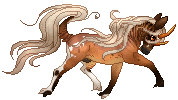Maple Island Ponies (equus cornutus) are a subspecies of equine found on the 70 000 square kilometre expanse of the Maple Islands. The ponies have been largely isolated from humans and other equines for hundreds of thousands of years, and as such have adapted to suit their specific environment.
The ponies are generally small, measuring around 10-12.2hh most of the time, though some individuals can be as small as 9hh or as tall as 14.3hh at the withers. They have small, tough hooves with a small amount of feathering, short legs and somewhat pudgy bodies. Males tend to display brighter colouration and flashier patterns, and have longer hairs over the chest, whereas mares tend to have sleeker coats with more neutral colouring. The manes and tails of females can grow quite a bit longer than those on males, which tend to be shorter and mostly upright. Many are very sure-footed, and have excellent stamina and agility. A most peculiar trait, and the species greatest identifier, are the horns that have developed on their heads. Maple Island Ponies have developed horns which usually grow from just behind the ears, though some are formed elsewhere on the skull, many of which mimic horns of other species. It is extremely rare to find a Maple Island Pony without horns, though it is possible. Maple Island Ponies are very long-lived, and can live up to their mid-thirties even in the wild; in captivity, some have been known to survive and even breed into their forties.
Maple Island Ponies come in all regular horse colours, as well as a few special ones, and will come with a nifty little code called a genotype. The genotype of a horse shows what genes they possess and have the ability to pass onto their offspring. I won't be explaining existing horse colour genetics, but will answer questions if needed. If you're interested in learning about basic colour genetics, or are interested in finding out what a possible foal will look like, the links below can be very useful! However, you don't need knowledge of genetics to enjoy owning your very own Maple Island Pony.
An Interactive Introduction to Horse Colour Genetics
Coat Colour Calculator
Punnet Square Calculator (useful to show the possible genotypes of foals, can calculate up to 5 traits at a time)
the above links in no way belong to me, and are only to be used for educational purposes
Because all breeding of MIPs is regulated, any breedings that could result in a lethal foal will not go through.
The ponies are generally small, measuring around 10-12.2hh most of the time, though some individuals can be as small as 9hh or as tall as 14.3hh at the withers. They have small, tough hooves with a small amount of feathering, short legs and somewhat pudgy bodies. Males tend to display brighter colouration and flashier patterns, and have longer hairs over the chest, whereas mares tend to have sleeker coats with more neutral colouring. The manes and tails of females can grow quite a bit longer than those on males, which tend to be shorter and mostly upright. Many are very sure-footed, and have excellent stamina and agility. A most peculiar trait, and the species greatest identifier, are the horns that have developed on their heads. Maple Island Ponies have developed horns which usually grow from just behind the ears, though some are formed elsewhere on the skull, many of which mimic horns of other species. It is extremely rare to find a Maple Island Pony without horns, though it is possible. Maple Island Ponies are very long-lived, and can live up to their mid-thirties even in the wild; in captivity, some have been known to survive and even breed into their forties.
Maple Island Ponies come in all regular horse colours, as well as a few special ones, and will come with a nifty little code called a genotype. The genotype of a horse shows what genes they possess and have the ability to pass onto their offspring. I won't be explaining existing horse colour genetics, but will answer questions if needed. If you're interested in learning about basic colour genetics, or are interested in finding out what a possible foal will look like, the links below can be very useful! However, you don't need knowledge of genetics to enjoy owning your very own Maple Island Pony.
An Interactive Introduction to Horse Colour Genetics
Coat Colour Calculator
Punnet Square Calculator (useful to show the possible genotypes of foals, can calculate up to 5 traits at a time)
the above links in no way belong to me, and are only to be used for educational purposes
Because all breeding of MIPs is regulated, any breedings that could result in a lethal foal will not go through.
Disclaimer:
The links above only cover so much, because there is only so much we know about equine colour genetics so far. As such, I've filled in some blanks below that will apply only to Maple Island Ponies. The traits described may (or may not) be real traits, but because I have been unable to find an explanation for them which would allow me to regulate how they are passed on to offspring, I've created our own explanation.

